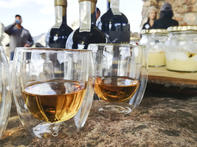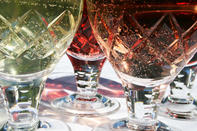Pretty to Drink
Pretty to look at and pretty to drink, rosé is the summer standard for many wine enthusiasts who prefer their wine light and sweet. How exactly is this glittery beverage made? Using red wine grapes, which are fermented following the same process of standard red wine production, however in this instance, the process takes a slightly different turn.

Interesting fact: when grapes are juiced, the liquid that forms is clear and not representative of the grape it came from. In order for wine to assume a certain colour, the grape ‘juice’ needs to come in contact with the skin of grapes for a certain period of time. This process is called maceration.
For rosé wines, the maceration process involves bringing the grape skin in contact with the ‘juice’, with a reduced period of contact time in order to achieve a pink colour as well as its signature airy taste. Rosé wines are generally made from a variety of wine grapes and as such can be called a blended wine.
As the name indicates, dessert wines are usually a wine pronounced by its sweetness and high alcohol content. Generally it functions as an accompaniment to desserts and can also be enjoyed by itself, in short acting as the delectable treat.
When pairing your dessert wine of choice, be sure to choose a meal that is sweeter than or of the same sweetness as the wine itself, so as not to affect the notes of the wine. There are 5 standard varieties of dessert wines: fortified wines, noble rot wines, dried grape wines, and iced wines.
Fortified and Noble
Fortified wines are wines that have been boosted by additional alcohol that is added during the fermentation process. Typically the additional alcohol is brandy. The sweetness of the wine results from the residual unfermented sugar that stems from the added alcohol, which achieves both sweetness and a high alcohol content. Examples of fortified wine are Port, Sherry, Madeira, and Marsala.
An oxymoron or a paradoxical statement, whichever one applies, noble rot wines gained its name from the fungus, Botrytis cinera, which attacks the wine grape causing it to wrinkle and leak water leaving behind a sweet semi-liquid, which is then pressed into a juice. Producing this wine requires a considerable amount of effort and precision in terms of knowing when to pick the grapes.
Similar to a ticking time bomb, if the grapes are picked too late the fungus would have destroyed all hope of producing a dessert wine, picked too soon and the wine produced will be decidedly not sweet enough.
Noble rot wines such as the late harvest varieties of Riesling and Chardonnays are particularly well paired with rich desserts and cheeses.
Dried and Iced

Think wine made from dried fruit, and you basically understood the concept of dried grape wines - sweet, really sweet wine made from dried grapes, commonly known as raisins. Another name for this type of wine is passum. Grapes are either left on the vine to dry or dried after it has been harvested. The latter method is called appassimento, which is a process that involves drying grapes in special rooms designed for that function before fermentation occurs.
With the evaporation of water from the grapes, a high natural sugar content remains, which is what allows dried grape wines to retain its distinguishing pronounced sweet character. A popular dried grape wine is Amarone, which is produced in the Italian province of Veneto. Shakespeare lovers will recognise the location as being the setting for Romeo and Juliet; a fitting location for a wine that is in a class of its own.
As the narrative goes, in Franken, Germany, during a notably cold winter in 1794, winemakers had no choice but to use the harvested grapes, which were decidedly frozen for their standard winemaking. This change of routine resulted in the serendipitous production of iced wine with a high sugar content and an intense flavour profile. Soon after, iced wine production became popular in Germany, particularly in the Rheingau area, where during the mid-1800s iced wine was known as “eiswein”, which is what it is still called today.
Iced wine is made by using grapes that have been frozen at approximately -7ºC and placed in a grape crusher, after which it is transferred to a grape press. This is a laborious process that has been known to result in the breakage of heritage grape presses due to the pressure exerted in extracting the concentrated grape sugar syrup out of the frozen grapes. An approximation of 10-20% of the extracted sugar syrup is used in the iced wine production as the concentrated ‘juice’ is remarkably sweet (roughly 32-46 Brix). The fermentation process can take 3 to 6 months to complete. Once the eiswein is ready for consumption it is said to have an approximation of 10% alcohol by volume and a level of sweetness that is approximately 160 to 220 gram per litre of residual sugar (g/L of RS).
Wines can only be assigned the label of being an ‘iced wine’ if the grapes were naturally frozen. This means that wines made from grapes that were commercially frozen can only be called dessert wines. This type of wine pairs well with subtle desserts and softer cheeses due to its fruity flavours and high level of sweetness.